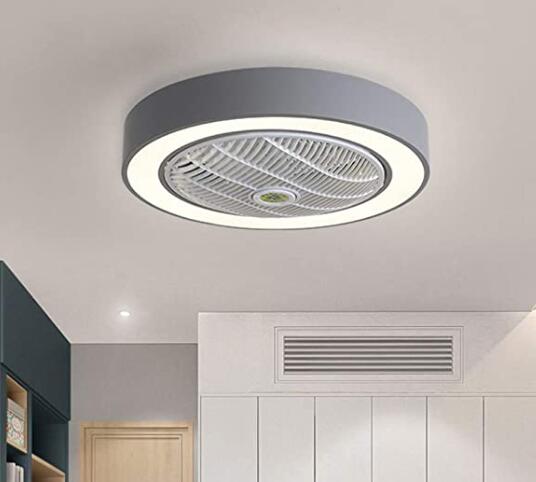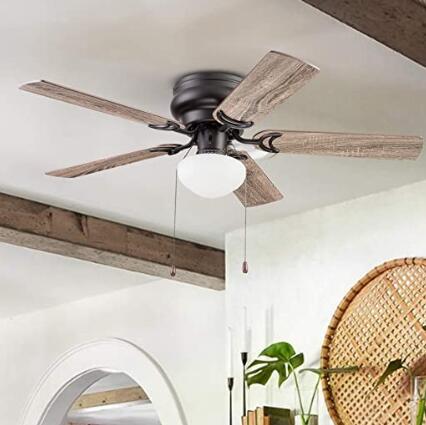The key to a good fan application in your indoor space is to understand its installation and fitting requirements? Some fans will extend their life span if installed well and fit in a way that they can supply the whole room with a continuous supply of fresh and cool air. With content online providing installation process and key consideration, you can achieve a proper working condition.
It is then wise to consider understanding each component of your fan and its installation procedure before making any move in fitting or mounting your fan in the wall. From wall mounting to the required height of installing your fan, the guide will explore some basic and technical factors on ceiling fan installation and purchasing for a proper working and fresh airflow in your room.
Picking the Best Low Mount Ceiling Fans For Your Needs
What Is A Low Mount for A Ceiling Fan?
The best or most preferred huggers are always ceiling light fans for both low-profile and flush-mount designs. Huggers or flush-mount fans refer to ceiling and wall fans that include down rod and are installed to your ceiling. Most of the market designs provide you with an interchangeably brand known as flush-mount ceiling models and work well in small rooms and low ceiling spaces. The low mount also provides you with a compatible design that always lumps the fan blades together, giving it a low-profile type. This can vary from one fan to another and depend on users’ manual specifications, as the guide will explain below.
Low-profile Vs. Hugger Ceiling Fans
Choosing one of them depends on your home and room size; most of them are designed to fit in short and small rooms. Small or short ceiling rooms, though not necessarily a small low profile flush mount model, will enhance your home airflow. All flush-mount and huggers are low-profile, but this doesn’t mean that all low mount brands are huggers or flash-mounts.
Besides, a low mount fan is any model that can be mounted in any ceiling below 12 inches. In addition, low mount ceiling fans include a down rod, while the huggers have no down rods. This implies that even if the huggers are the most preferred by many homeowners, they don’t provide enough compared to low-mount ceiling fans.
These fans provide you with a compact design for small and low-profile ceilings but entail many features. It doesn’t matter the size of your house; what matters most is the type and installation process you get on each design. It is then wise to learn more or find more information about each brand online before making any move towards buying and installing. The point here is to customize your indoor space and still get the best fan effect. Stick around and understand the market better because a complete guide on the right fan makes a good purchase.
What Does Low Profile Mean For A Ceiling Fan?
A low-profile ceiling fan simply means a brand that can be mounted or installed or hanged below a 12 inches ceiling height. Some guides will include the presence of a down rod and try to compare it with other fans in the market, such as huggers. Most low-profile fans incorporate a metal shaft or rod that connects the fan motor unit to the circuit overhead. These down rods come in different lengths, but this doesn’t affect any fan performance; they are things you can replace and set according to your personal needs.
Installation of low-profile fans should be done with care have they hang very low and taller people might not like it or get injured in the process. Low-profile fans also work to solve small-sized room cooling effects as normal and typical fans provide a lot to such rooms, making them uncomfortable.
Low profile fans also have some advantages in their installation process as they allow you to have a direct installation without the fitting and application of a down rod. This simply means that they have an ability to hang as low as you need them or as high as you like. They also have a simple mounting process by allowing you to have a flush mounting process with your ceiling or the wall.
One thing about all low-profile fans si that they work well in small space and provide a quality solution to air quality in the house. Some dealers sell low-profile fans with a complete installation unit, which means you don’t have to buy any whistles and installation units and minimize space in your indoor environment.
Why a Low-profile Ceiling Fans
Less and Desirable Airflow
Low-profile fans are designed to provide you with desirable airflow; they work in ensuring that each operation they make provides enough air in your home, unlike other types. This is because the airflow is limited and restricted to the ceiling, and circulating a larger air is not possible. If you wish to increase its operations, then you can apply a down rod to lower its blade from the ceiling.
Installation Safety Tip:
All low-profile fans should be installed properly with all installation procedures followed. Before operating, ensure that all the operational units and vibration caused by the fan are put into an account and proper support system designed to avoid failing or lose operations in your ceiling. All the junction boxes should be in good condition to avoid short-circuiting, and if you have no idea about the whole installation process, find more information online or in the user manual. It is also wise to hire qualified personnel to help you install your fan as they understand what it takes to good operation. Other personnel like interior design for remodeling and electricians should play a role in finalizing the whole process.
Ceiling Too Low For Ceiling Fan, How To Recess A Ceiling Fan
Hanging your fan depends on how you have installed the holding holes to the joists, with good holes and screwed well you can use this support to hold your down rod well and drop your fan to any height you wish. But this should at least meet the airflow and air quality standards or having any cooling or air circulation kit in the middle and at least seven feet above the floor.
If you are using your wall, then it should be at least 19 to 20 inches from the wall. This is the ideal height to hang your low-profile fan, but you can do more than this if you like, but to achieve an optimal airflow, the required height should apply. It is dictated that a low mount is 12 to 15 inches to be the right mounting distances in all indoor spaces. For blades distance, the down rod plays a key role in ensuring that each distance you set is safe. However, this distance should be at least 7 to 11 inches between the fan blades and the floor, and the installation height of 7 feet still applies.
How Do You Calculate The Cfm For A Ceiling Fan At A Low Speed?
CFM refers to cubic feet per sixty seconds, and it is the universal way to measure the fain airflow rate. Having an accurate value or size of your room can help you get the right fan by calculating each fan’s CFM. Calculating CMF help in choosing the right fan size and blades for your home, though these measurements are taken when the fan is on high operations or speed. Some platforms have come up with a more accurate way to calculate the number of CFM of each fan at low speed.
Using a stopwatch or a pendulum count timer time your fan and count all the rotation it makes in one minute, then divide the number with the amount of power used to inform watts. The CFM simply allows you to choose the right fan that can operate in your room efficiently. The higher the CFM, the better the fan is into its operations, and the ideal fan in the market should have at least 75 CFM per watt, which is the minimum and the lowest efficiency in the energy requirements.
Besides, CFM helps indetermination on how much the fan is expected to provide clean and fresh air in a specific cubic feet room or basically the exchange rate per minute of the fan.
How To Pick A Ceiling Fan For Low Ceiling
Choosing a good low ceiling fan goes beyond the normal selection process in the market. You need all it takes to understand the right fan for your home and your low ceiling space. The guide always works in ensuring that each choice you make is the best by providing you with tips and guides on the best fan to buy. Without further much ado, here are some basic considerations that you should consider before buying a low-profile ceiling fan.
Design and Blades Sizes
When looking for a good low-profile fan, it is wise to consider its design and size of the blades. The two factors play a role in achieving your aim of installing a fan in your indoor environment. Take your time and find more information about each design and its efficiency and application in your home before buying. It is also wise to keep in mind that improving your home air quality is the main reason for buying and hanging a fan in your house. And to achieve them, a sable blade with a modem design provides the best solutions to your indoor approach.
Online Reviews
If you are new to low-profile or the whole fan purchasing tasks, it is wise to consider learning before making any move towards buying or mounting. Read more on each brand online how its users are saying about its operations. A good fan to buy as your low-profile brand is the one with higher Google ratings and with positive reviews in its comments sections. In addition to this, online reviews help you to have a complete copy of each fan application and quality depending on its rating and feedback.
Cost of the Fan
Price plays a role when it comes to fan and air quality solutions to install in your home. Unlike other market fans, low-profile designs have no relationship between price and quality airflow. And if you find a shop with higher prices doesn’t mean that they are dealing with high-quality brands. Understand the market first and try to compare the prices of each dealer for a cheaper choice.
What Fan For Low Ceiling Height?
Many people prefer huggers as they provide an ideal solution to rooms with ceilings height below 8 feet or in any situation where the fan is required to have optional lighting hanging on its joist. Huggers or low-mount provide a perfect solution as they fit well and limit the movement of excess air in the house. This feature allows them to be the best choice for all low ceiling homes. They also play the role of a regular fan when you lower the down rod and allow the blades to have a full rotational area for maximum airflow.
What Type Of Ceiling Fan Do I Need For A Low Slanted Ceiling?
For a low slanted ceiling, it is wise to consider fans with longer down rods or a fan that is designed to provide you with an adjacent operational angle with your slanted ceiling. Depending on the ceiling’s slanting angle, extra fitting equipment such as an angled mount adapter is required.
What Color Ceiling Fan For Low Ceiling
Many people prefer a subtle, stylish, and simple colors as their ceiling fan, white being one of the most preferred choices. This also depends on you, but the color you choose should blend with your walls and other home furniture. White also blends well because many ceilings are painted white, and having a white color will blend in well.
White Ceiling Fan For Low Ceiling
Conclusion
Having a clear picture of what to buy and installing it plays a major role when it comes to fans and their installation procedures. Different designs have different requirements, and our guide made a step further and summarized all for you. We can say that the above is all you need to make a wise choice when it comes to a low mount ceiling fan, but small research on top of this means a lot to your personal understanding.















